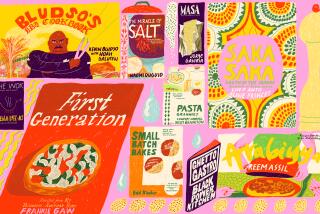Fall Fruit : IN THE KITCHEN : A Quince in Every Closet
- Share via
House guests frequently leave things behind. Deborah Madison left quinces.
It happened several years ago when my family and I were living in New Mexico and she was thinking of relocating there. We had mutual friends, so she came to stay with us for a couple of weeks and check things out while she was working on “The Greens Cookbook.”
We ate well during that time, relishing the kind of food for which Deborah has become known--simple in concept, yet with deep, complex flavors. That most of those dishes used fruits and vegetables as their centerpieces was almost incidental.
Obviously, one of the things that begged inspection during her visit was the local farmers market. So one crisp fall morning, we headed off. It was a small market--at that point farmers markets had not yet captured the popular imagination--and we walked it together, bundled in winter coats. I bought freshly roasted green chile and freshly harvested pinto beans; she picked through apples and winter squash.
Then she stopped. “Quinces!” she said, picking up a fruit I had never seen before. It was a deep-golden color and had the gravid, lumpy look of an ancient fertility symbol. In fact, it looked like nothing more than a caveman’s impression of a pear. That’s the way it felt too: hard and heavy.
No way could you eat that, I thought. But then I smelled it. This stony fruit had a perfume that penetrated the background smells of chile smoke and pinon with a scent that was an odd mingling of apples and honey.
*
Deborah bought the lot and brought them home. She peeled, quartered and cored most of the quinces and set them to cook for a couple of hours with sugar and spices. Then she took the rest and stuck one in each closet of the house as a kind of organic air freshener. We ate the cooked quinces mixed with some other fruits as a compote; they were wonderful. The pale, woody flesh had turned a deep, glowing rose color with an odd, cooked crispness similar to that of canned pears. The flavor was equal to the initial smell--a tangy combination of honey and spice and fall fruit.
That transformation has long endeared quinces to eaters. Originally from Asia Minor, quinces were much appreciated by the Greeks, who introduced them to the Romans, who in turn took them to England as well as Spain and Portugal, where they were called marmello and to this day lend their name to marmalade (even though marmalade is now most commonly made with bitter oranges).
Quince seeds were among the requests the Pilgrims sent back to England, and until the early 1800s, quince trees outnumbered apples and pears in this country--primarily because they propagated so easily and because the fruit’s durability kept it fresh longer in root cellars than the competition. But the long cooking required to render them delicious proved too much to overcome, and their popularity waned for a time.
But in 1872, an anonymous editor at Horticulturalist magazine was asking: “Why does not someone, of a careful turn of mind, forsaking the beaten path of fever for strawberries, cranberries, pears and peaches, study the characteristics of the quince and learn its needs of soil and climate and then follow them up by planting a good orchard?”
In the 1990s, it turns out, people are taking that advice. You can find quinces at most farmers markets and, in fact, at many local grocery stores. Frieda’s Finest, a Los Angeles exotic produce company, has been handling the fruit since 1968, but a spokesperson says they’re selling even more this year because of an unusually abundant crop.
*
When you’re buying them, look for fruit that is already deep-gold and fragrant. Unlike apples and pears, quinces do not continue to ripen off the tree. Also, though it may seem impossible to bruise something this hard, it does happen--and damaged quinces spoil very quickly.
The quinces that Deborah left in the closets turned up, wizened and mummified, a couple of years later when we moved, But whenever I’m in the market and come across that golden, gleaming fruit, I think of those first quinces and how the best cooking is really nothing more than the art of bringing beauty out of even the most inedible-seeming foods.
*
This recipe, from Deborah Madison’s second cookbook, “The Savory Way” (Bantam: $22.95), is the quince tart I referred to in last week’s column on kitchen disasters: The pastry is unbelievably delicate--so breakable I gave up on serving it as a double-crust pie and instead pinched and patted together a high-sided country tart in a springform pan, adding about another 1/2 cup of quince threads to the filling. (I also substituted some wonderfully winy raisins I found that were made from red flame grapes.) The difference between the two preparations is interesting. With a thinner layer of fruit between two crusts, the tart was like an elegant mincemeat. Open-faced, the additional quince flavor really came to the fore. Either way, the walnut crust was a big hit, making it worth the extra trouble.
PRUNE AND QUINCE TART IN WALNUT PASTRY
2 cups pitted prunes
4 cups dark tea
1 cup golden raisins
Quince Threads or quince jam
1/3 cup sugar
2 tablespoons Armagnac or brandy
2 teaspoons orange flower water, or to taste
1 teaspoon grated orange zest
Walnut Pastry
Powdered sugar, optional
Creme fraiche or sour cream, optional
Cut prunes into thirds or quarters. Add to tea and cook gently in saucepan until soft, from 10 to 20 minutes, depending on how hard prunes were to begin with. Just before removing from heat, add raisins, then let steep 5 minutes. Drain and transfer combination to bowl. Add 1/3 cup Quince Threads. Sprinkle with sugar, Armagnac, orange flower water and orange zest. Gently mix together. Set aside to cool.
Line 9-inch tart pan (with removable rim) with parchment or wax paper. This will prevent sugar in crust from caramelizing and sticking to pan.
On lightly floured surface or between 2 pieces of plastic wrap, roll out 1 disk of dough little larger than pan. Set dough in pan. If tears appear, patch by pressing dough together. Make sure sides are about 1/4-inch thick.
When filling is cool, spread 1/2 cup additional Quince Threads in thin layer over bottom and add cooled fruit. Spread to even. If desired, dab extra Quince Threads on top of tart.
Roll out second circle of dough and lay over pie. Pinch sides together, cut star pattern or X in center and chill until dough is firm, about 10 minutes. Set chilled tart on baking sheet in center of 375-degree oven and bake until crust is lightly browned over surface, about 50 minutes. If edges darken before top, cover loosely with strips of foil.
When tart is done, remove from oven and, holding firmly, gently lift bottom slightly up and away from side, working way around circumference to cool outside of crust. (This will harden sugars so they won’t stick later.) Twice around should be enough. Return tart to pan and set on cooling rack until ready to serve.
Remove from pan, set on serving plate and dust surface with powdered sugar. Serve with bowl of creme fraiche, beaten until smooth and silky. Makes 8 to 10 servings.
Each of 8 servings contains about:
518 calories; 45 mg sodium; 57 mg cholesterol; 20 grams fat; 83 grams carbohydrates; 7 grams protein; 1.69 grams fiber.
*
You will use less than a third of this recipe. The rest can be saved and used on toast or in other pastries. Notice that this recipe must be started the day before.
*
Quince Threads
1 1/2 pounds quinces
4 cups sugar
2 cups water
Grated zest 1 lemon or orange
Lemon juice
Rub fuzz, if any, off quince skins, then grate coarsely. If using food processor, quarter quinces first, then cut away cores. Don’t worry about grated quinces discoloring, since they will be cooked.
Bring sugar and water to boil. Boil vigorously about 1 minute, then add quinces. Allow syrup to return to boil, then stir frequently, pushing fruits into liquid until saturated enough to stay below surface of syrup. Add zest, lower heat and cook slowly until threads have turned dark rosy pink, about 1 1/2 hours.
Let preserve stand overnight. Next day, add lemon juice to taste. Return to boil and cook over low heat until most of syrup is gone and jam is uniform in texture and fairly wet.
Sterilize canning jars and fill with preserve. Attach lids and process according to manufacturer’s directions. Makes 5 cups.
*
Walnut Pastry
1 1/2 cups unbleached all-purpose flour
1/3 cup sugar
3/4 cup finely ground walnuts
Dash salt
1/2 cup unsalted butter
1 egg
1/4 teaspoon vanilla extract
Toss flour, sugar, walnuts and salt together in bowl. Cut in butter, using wire pastry blender, your fingers or food processor. Work butter until dispersed through dry ingredients. In bowl beat egg with vanilla. Then pour over dough.
Lightly work into dough, using fork or your fingers, then turn out onto counter and knead briefly to bring together. Divide dough into 2 equal pieces. Flatten into round disks, wrap and refrigerate or freeze until needed. Makes 1 (9-inch) double-crust tart.
More to Read
Eat your way across L.A.
Get our weekly Tasting Notes newsletter for reviews, news and more.
You may occasionally receive promotional content from the Los Angeles Times.











